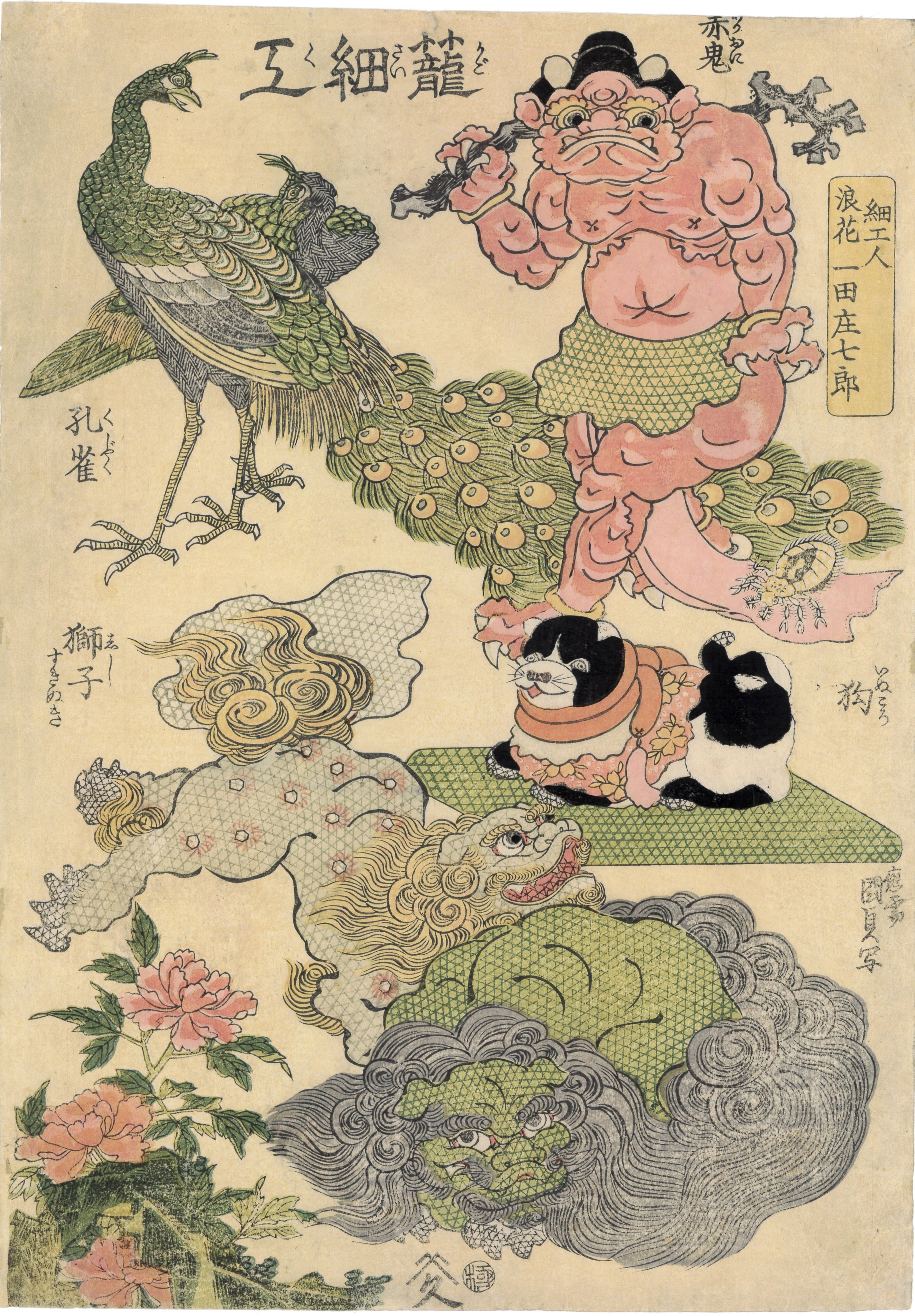Kunisada (Toyokuni III) | Basketry Work- By the Craftsman Ichida Shoshichiro of Naniwa
歌川国貞(三代目歌川豐国) Utagawa Kunisada (Toyokuni III) (1786–1865)
笼细工 浪花细工人一田庄七郎
Basketry Work- By the Craftsman Ichida Shoshichiro of Naniwa
1819
木版画 | 纵绘大判 | 38cm x 26.7cm
Woodblock-print | Oban tate-e | 38cm x 26.7cm
早期版次;颜色鲜艳;品相非常好;非常轻微的修剪;罕见的作品
Fine impression, color; slight trimmed, otherwise good condition; rare
$4,800
笼细工,即竹编工艺,是一门在日本有着悠久历史的传统手工艺。在江户时代,就曾举办过一场引起大阪、江户、名古屋三城轰动的著名笼细工展览——“浪花一田庄七郎的笼细工”。身为大阪首屈一指的笼细工匠人,一田庄七郎能以平平无奇的竹篾为材,编织出栩栩如生的花鸟走兽、神佛鬼怪;甚至还能制作出高达七八米的巨型作品,可谓壮观至极。在通过首次展览走红之后,他便趁热打铁,将此种新潮流带到了江户,在浅草寺观音殿前展出了自己的“江户出道作”,一时间风光无两,参观人流络绎不绝。
本作中描绘的便是一田庄七郎的各类作品。仔细观瞧,无论是拧眉瞪眼的赤鬼、毛发拳曲的狮子,还是楚楚可怜的小狗、优雅雍容的孔雀,在它们的身上,都会有些许部位由细密的六角形网格纹或编织纹所呈现,这也正是向观者无声地说明,它们其实都是用竹篾编织而成的艺术作品。
值得一提的是,在画面右下方国贞落款前可见“应需”字样。这有力地表明了本作正是版元为扩大展览的影响力、增加销售额而特地向国贞订制的“展览图录”。商业与艺术的完美统一,又通过本作体现得淋漓尽致。
*关于笼细工的详细介绍文章,请移步至“浮世绘知识文章—浮世绘碎碎念”
Interested in purchasing?
Please contact us.
歌川国貞(三代目歌川豐国) Utagawa Kunisada (Toyokuni III) (1786–1865)
笼细工 浪花细工人一田庄七郎
Basketry Work- By the Craftsman Ichida Shoshichiro of Naniwa
1819
木版画 | 纵绘大判 | 38cm x 26.7cm
Woodblock-print | Oban tate-e | 38cm x 26.7cm
早期版次;颜色鲜艳;品相非常好;非常轻微的修剪;罕见的作品
Fine impression, color; slight trimmed, otherwise good condition; rare
$4,800
笼细工,即竹编工艺,是一门在日本有着悠久历史的传统手工艺。在江户时代,就曾举办过一场引起大阪、江户、名古屋三城轰动的著名笼细工展览——“浪花一田庄七郎的笼细工”。身为大阪首屈一指的笼细工匠人,一田庄七郎能以平平无奇的竹篾为材,编织出栩栩如生的花鸟走兽、神佛鬼怪;甚至还能制作出高达七八米的巨型作品,可谓壮观至极。在通过首次展览走红之后,他便趁热打铁,将此种新潮流带到了江户,在浅草寺观音殿前展出了自己的“江户出道作”,一时间风光无两,参观人流络绎不绝。
本作中描绘的便是一田庄七郎的各类作品。仔细观瞧,无论是拧眉瞪眼的赤鬼、毛发拳曲的狮子,还是楚楚可怜的小狗、优雅雍容的孔雀,在它们的身上,都会有些许部位由细密的六角形网格纹或编织纹所呈现,这也正是向观者无声地说明,它们其实都是用竹篾编织而成的艺术作品。
值得一提的是,在画面右下方国贞落款前可见“应需”字样。这有力地表明了本作正是版元为扩大展览的影响力、增加销售额而特地向国贞订制的“展览图录”。商业与艺术的完美统一,又通过本作体现得淋漓尽致。
*关于笼细工的详细介绍文章,请移步至“浮世绘知识文章—浮世绘碎碎念”
Interested in purchasing?
Please contact us.
歌川国貞(三代目歌川豐国) Utagawa Kunisada (Toyokuni III) (1786–1865)
笼细工 浪花细工人一田庄七郎
Basketry Work- By the Craftsman Ichida Shoshichiro of Naniwa
1819
木版画 | 纵绘大判 | 38cm x 26.7cm
Woodblock-print | Oban tate-e | 38cm x 26.7cm
早期版次;颜色鲜艳;品相非常好;非常轻微的修剪;罕见的作品
Fine impression, color; slight trimmed, otherwise good condition; rare
$4,800
笼细工,即竹编工艺,是一门在日本有着悠久历史的传统手工艺。在江户时代,就曾举办过一场引起大阪、江户、名古屋三城轰动的著名笼细工展览——“浪花一田庄七郎的笼细工”。身为大阪首屈一指的笼细工匠人,一田庄七郎能以平平无奇的竹篾为材,编织出栩栩如生的花鸟走兽、神佛鬼怪;甚至还能制作出高达七八米的巨型作品,可谓壮观至极。在通过首次展览走红之后,他便趁热打铁,将此种新潮流带到了江户,在浅草寺观音殿前展出了自己的“江户出道作”,一时间风光无两,参观人流络绎不绝。
本作中描绘的便是一田庄七郎的各类作品。仔细观瞧,无论是拧眉瞪眼的赤鬼、毛发拳曲的狮子,还是楚楚可怜的小狗、优雅雍容的孔雀,在它们的身上,都会有些许部位由细密的六角形网格纹或编织纹所呈现,这也正是向观者无声地说明,它们其实都是用竹篾编织而成的艺术作品。
值得一提的是,在画面右下方国贞落款前可见“应需”字样。这有力地表明了本作正是版元为扩大展览的影响力、增加销售额而特地向国贞订制的“展览图录”。商业与艺术的完美统一,又通过本作体现得淋漓尽致。
*关于笼细工的详细介绍文章,请移步至“浮世绘知识文章—浮世绘碎碎念”
Interested in purchasing?
Please contact us.
Utagawa Toyokuni III (1786–1865)
In the pantheon of Japanese woodblock prints, some names loom large and legendary – Hokusai, Hiroshige, Utamaro, to name a few. Each in his own way revolutionized his genre. But for sheer productivity and quality and longevity, no one rivals the great Utagawa Kunisada. He was without a doubt the most prolific Ukiyo-e artist of the Edo period, and the quality of his work was remarkably high throughout his lifetime.
His life caught the tail end of the early golden age of Ukiyo-e and ended during the final, halcyon days of Japanese woodblock printmaking. His legacy lived on with many famous pupils. In between, he produced countless designs of bijin (beautiful women), warriors, legends, Surimono, more bijin, the Tale of Genji, actors, landscapes, Shunga, fan prints and even more bijin. He led the Utagawa School, home to Hiroshige among others, for nearly 40 years.
His work embraced a subtle elegance and simplicity, a timelessness, when other woodblock artists often favored busy energy. Except when it didn’t. (Read on.)
He was born in 1796 and always had a steady income from his family’s ferry business – making him unusual in the world of Ukiyo-e, where so many struggled to make ends meet. He became a student of Toyokuni when he was 15. The master gave him the name Kunisada, using the tradition of a teacher starting a student’s name with the end of his own.
After getting his start doing book designs, Kunisada saw his first major successes in the 1820s. His initial specialties were bijin and warriors, as well as erotic books. He often put his subjects in well-drawn landscapes but rarely produced pure landscapes themselves.
One example of this occurred in the early 1830s when, reacting to the runaway success of Hiroshige’s Great Tokaido series, he began his own series that copied Hiroshige’s designs but placed a beautiful woman in the foreground. While Hiroshige’s prints were oban yoko-e (horizontal oban prints), Kunisada’s “copies” were smaller chuban-size prints, meaning two could be cut from a single oban-sized sheet. These little prints were phenomenally successful – as successful at least as Hiroshige’s – and eventually Kunisada was publishing his little Tokaido prints ahead of Hiroshige’s, and thus designing his own background landscapes.
Kunisada would later produce the “two-brush” Tokaido series with Hiroshige in the 1850s, in which he drew figures in the foreground while Hiroshige supplied beautiful little landscapes behind them. This was one of several notable woodblock print collaborations during his lifetime.
By then, Kunisada had taken the name Toyokuni III, to honor his master. (Toyokuni II had already been taken by Toyoshige, though Kunisada didn’t acknowledge the legitimacy. But that’s another story for another day.)
He kept going and going. In fact, in his long life, 1852 was his most productive year. His design skills were later matched by new technologies in woodblock prints, and some of his final series feature spectacular and intricate production, such as “Lasting Impressions of a Later Genji Collection” in 1859-61 and “A Contest of Magic Scenes by Toyokuni” in 1861-4. Okay – this series was not subtle: It featured over-the-top designs of Kabuki actors with fabled and ghostly beasts. Double-printing, mica, burnishing, raised printing, heavy paper, complex bokashi – no expense was spared for these deluxe editions.
Kunisada was generous with his students, many of whom went on to great success, including Kunichika, Kunisada II, Sadahide, and Kunihisa II. This last pupil, who among other projects designed the in-set landscapes in Kunisada’s wonderful “100 Famous Sights in Edo Matched with Beautiful Women” in 1857-1858, was a rarity among Ukiyo-e artists – a woman.
Kunisada died in 1865, just three years before the end of the Tokugawa epoch, leaving behind a body of work unmatched in his time.
Don’t believe me? Checkout The Kunisada Project. It’s all there. Just make sure you have some time.
Citation: Research for this brief biography included “Japanese Woodblock Prints” by Andreas Marks (Tuttle; 2010), among other sources.


